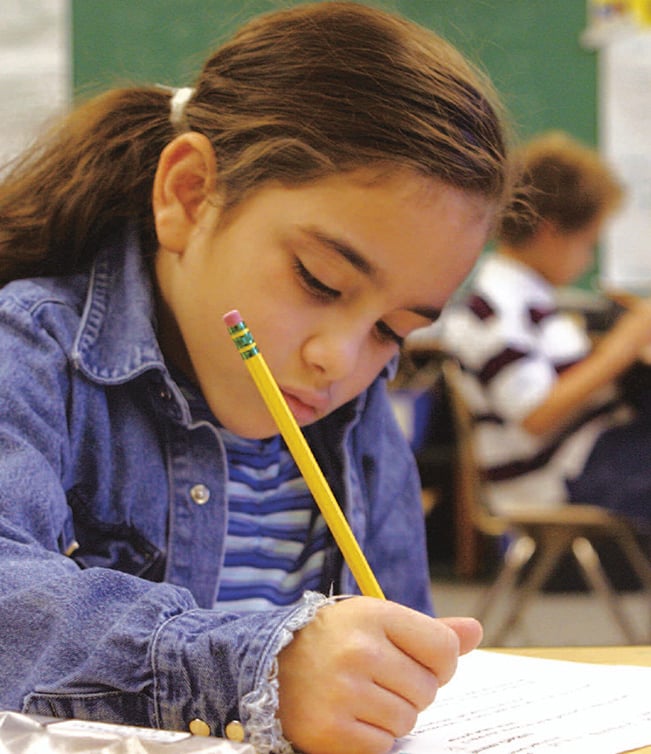
By Anna Gratz Cockerille
When they are motivated, children naturally engage in deep reflection and goal-setting. An example is when they are trying to get better at their favorite sport or video game. They understand exactly where they rank compared to other players. They study other players carefully, trying to emulate their moves. They take in what coaches say, they make small tweaks to improve. They practice, practice, practice. With the right conversations and the right tools, we can teach students to approach their writing with the same level of reflection and goal-setting.
There is so much power in teaching young writers to closely study their own writing in order to fuel their own course of improvement. To do this, they need tools that give them lenses and language to analyze their writing in effective ways. An example is the set of checklists that accompany the Units of Study for Opinion, Information, and Narrative Writing by Lucy Calkins and colleagues. These checklists are written in student-facing language and highlight the most important qualities of good writing for each writing genre. By placing these tools into students’ hands and explaining to them that these tools will help them to take charge of their own writing lives, you set writers on a course of self-reflection and empowerment.
When students are using the same language to talk about and understand each others’ writing, and when they are working collaboratively to set goals to get better, you infuse your classroom with a transformative energy. Writing is no longer a solitary experience. It is a shared event, in which students cheerlead, mentor, compliment, and coach each other and themselves. They will be the kind of writers who study, share, and take risks. Their writing will never be the same.
Of course, students are not the only ones studying their writing in order to improve. Teachers as well need shared language and tools to study kids’ writing collaboratively and to plan a course of instruction. When teachers use versions of the same tools that students use, there is transparency and shared responsibility in what improvement looks like. The teacher versions of the tools might be worded in more complex ways, as are the teacher-facing rubrics that match the student checklists in the Units of Study, but their end goals for writers are the same.
Imagine the power then, when all teachers and students on a grade level and across a school use matching tools to study writing so that they are talking, thinking, and working on writing in the same ways. The result is extraordinary.
TCRWP staff developers Gary Petersen, Eric Hand, and Jenn Kean-Thompson will lead this week’s Twitter chat on ways to use on-demand writing to generate powerful discussions and instruction. The creativity and thought so many teachers put into studying students’ on-demand writing and helping students to improve in shared, transparent ways has been marvelous. Please join on Wednesday to share and hear more about how this work can go in your classroom and school.
♦ ♦ ♦ ♦
Each Wednesday night at 7:30pm eastern, The Teacher's College Reading and Writing Project hosts a Twitter chat using the hashtag #TCRWP. Join @garycally, @eric_hand_tc, & @jennkeant tomorrow evening to chat about ways to use on-demand writing samples for powerful discussion and instruction.
♦ ♦ ♦ ♦
Not on Twitter? Take Heinemann’s free Twitter for Educators course here.
 Anna Gratz Cockerille, Coauthor of Bringing History to Life (Grade 4) in the Units of Study for Teaching Writing Series.
Anna Gratz Cockerille, Coauthor of Bringing History to Life (Grade 4) in the Units of Study for Teaching Writing Series.
Anna was a teacher and a literacy coach in New York City and in Sydney, Australia, and later became a Staff Developer and Writer at TCRWP. She served as an adjunct instructor in the Literacy Specialist Program at Teachers College, and taught at several TCRWP institutes, including the content literacy institute, where she helped participants bring strong literacy instruction into social studies classrooms. Anna also has been a researcher for Lucy Calkins, contributing especially to Pathways to the Common Core: Accelerating Achievement (Heinemann 2012), and Navigating Nonfiction in the Units of Study for Teaching Reading, Grades 3–5 series (Heinemann 2010). Most recently, Anna served as an editor for the Units of Study for Teaching Reading, K–5 series.


